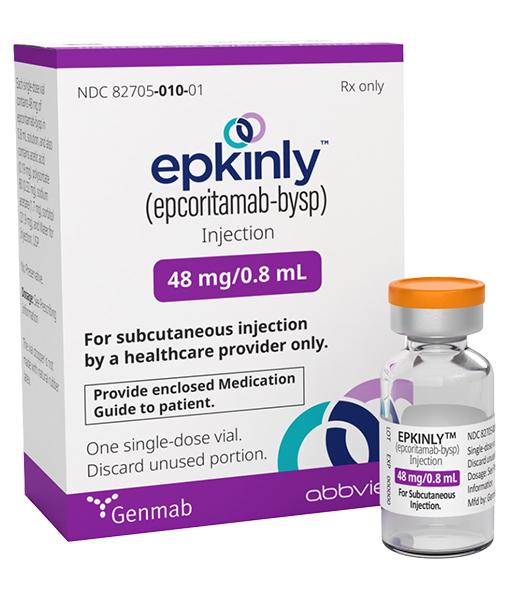Epcoritamab Side Effects
Medically reviewed by Drugs.com. Last updated on Jun 21, 2023.
Applies to epcoritamab: subcutaneous solution.
Warning
Subcutaneous route (Solution)
Warning: Cytokine Release Syndrome and Immune Effector Cell-Associated Neurotoxicity SyndromeCytokine release syndrome (CRS), including serious or life-threatening reactions, can occur in patients receiving epcoritamab-bysp. Initiate treatment with the epcoritamab-bysp step-up dosing schedule to reduce the incidence and severity of CRS. Withhold epcoritamab-bysp until CRS resolves or permanently discontinue based on severity.Immune Effector Cell-Associated Neurotoxicity Syndrome (ICANS), including life threatening and fatal reactions, can occur with epcoritamab-bysp. Monitor patients for neurological signs or symptoms of ICANS during treatment. Withhold epcoritamab-bysp until ICANS resolves or permanently discontinue based on severity.
Serious side effects of Epcoritamab
Along with its needed effects, epcoritamab may cause some unwanted effects. Although not all of these side effects may occur, if they do occur they may need medical attention.
Check with your doctor or nurse immediately if any of the following side effects occur while taking epcoritamab:
More common
- Back pain
- bloating or swelling of the face, arms, hands, lower legs, or feet
- chest pain or discomfort
- decreased appetite
- difficulty in moving
- dizziness
- fainting
- fast, slow, or irregular heartbeat
- headache
- joint pain
- lightheadedness
- muscle aches, cramps, or stiffness
- muscle or bone pain
- nausea
- neck pain
- pain in the arms or legs
- palpitations
- pounding or rapid pulse
- rapid weight gain
- rash with flat lesions or small raised lesions on the skin
- stomach pain
- swollen joints
- tingling of the hands or feet
- trembling and shaking of hands
- trouble breathing
- unusual tiredness or weakness
- unusual weight gain or loss
- vomiting
Less common
- Black, tarry stools
- bleeding gums
- blood in the urine or stools
- body aches or pain
- chest tightness
- chills
- confusion
- cough
- ear congestion
- fever
- loss of voice
- lower back or side pain
- painful or difficult urination
- pale skin
- pinpoint red spots on the skin
- problems with speech or speaking
- sneezing
- sore throat
- stuffy or runny nose
- ulcers, sores, or white spots in the mouth
- unusual bleeding or bruising
- unusual drowsiness, dullness, tiredness, weakness or feeling of sluggishness
Rare
- Anxiety
- dark urine
- pain or discomfort in the arms, jaw, back, or neck
- sweating
- yellow eyes or skin
Other side effects of Epcoritamab
Some side effects of epcoritamab may occur that usually do not need medical attention. These side effects may go away during treatment as your body adjusts to the medicine. Also, your health care professional may be able to tell you about ways to prevent or reduce some of these side effects.
Check with your health care professional if any of the following side effects continue or are bothersome or if you have any questions about them:
More common
- Bleeding, blistering, burning, coldness, discoloration of skin, feeling of pressure, hives, infection, inflammation, itching, lumps, numbness, pain, rash, redness, scarring, soreness, stinging, swelling, tenderness, tingling, ulceration, or warmth at the injection site
For Healthcare Professionals
Applies to epcoritamab: subcutaneous solution.
General
The most common adverse reactions were cytokine release syndrome (CRS), fatigue, musculoskeletal pain, injection site reactions, pyrexia, abdominal pain, nausea, and diarrhea. Serious adverse reactions include infections, CRS, pleural effusion, febrile neutropenia, fever, and immune effector cell-associated neurotoxicity syndrome (ICANS). Fatal adverse reactions leading to discontinuation occurred in 3.8% of patients. These fatal reactions include COVID-19, hepatotoxicity, ICANS, myocardial infarction, and pulmonary embolism.[Ref]
Cardiovascular
Very common (10% or more): Cardiac arrhythmias (includes bradycardia, sinus bradycardia, sinus tachycardia, supraventricular extrasystoles, supraventricular tachycardia, and tachycardia) (10%)
Common (1% to 10%): Myocardial infarction[Ref]
Dermatologic
Very common (10% or more): Rash (includes dermatitis bullous, erythema, palmar erythema, penile erythema, rash erythematous, rash maculopapular, rash pustular, recall phenomenon, seborrheic dermatitis, and skin exfoliation) (15%)[Ref]
Gastrointestinal
Very common (10% or more): Abdominal pain (includes abdominal discomfort, pain, lower and upper abdominal pain, and tenderness) (23%), diarrhea (20%), nausea (20%), vomiting (12%)[Ref]
Hematologic
Very common (10% or more): Decreased lymphocyte count (87%), decreased hemoglobin (62%), decreased white blood cells (53%), decreased neutrophils (50%), decreased platelets (48%)[Ref]
Immunologic
Very common (10% or more): Cytokine release syndrome (51%)
Common (1% to 10%): Immune effector cell-associated neurotoxicity syndrome[Ref]
Local
Very common (10% or more): Injection site reactions (includes erythema, hypertrophy, inflammation, mass, pain, pruritus, rash, swelling, and urticaria) (27%)[Ref]
Metabolic
Very common (10% or more): Decreased appetite (12%)[Ref]
Musculoskeletal
Very common (10% or more): Musculoskeletal pain (includes back pain, bone pain, flank pain, musculoskeletal pain, myalgia, neck pain, non-cardiac chest pain, pain, pain in extremity, and spinal pain) (28%)[Ref]
Nervous system
Very common (10% or more): Headache (13%)[Ref]
Other
Very common (10% or more): Fatigue (29%), pyrexia (24%), edema (14%), decreased sodium (56%), decreased phosphate (56%), increased aspartate aminotransferase (48%), increased alanine aminotransferase (45%), decreased potassium (34%), decreased magnesium (31%), increased creatinine (24%), increased potassium (21%)
Frequency not reported: Infections (includes sepsis, COVID-19, pneumonia, and upper respiratory tract infections), febrile neutropenia[Ref]
Respiratory
Uncommon (0.1% to 1%): Pulmonary embolism
Frequency not reported: Pleural effusion[Ref]
Hepatic
Common (1% to 10%): Hepatotoxicity[Ref]
More about epcoritamab
- Check interactions
- Compare alternatives
- Reviews (1)
- Dosage information
- During pregnancy
- Drug class: CD20 monoclonal antibodies
- En español
Patient resources
Other brands
Professional resources
Other brands
Related treatment guides
References
1. Product Information. Epkinly (epcoritamab). Genmab US, Inc. 2023.
Further information
Always consult your healthcare provider to ensure the information displayed on this page applies to your personal circumstances.
Some side effects may not be reported. You may report them to the FDA.

